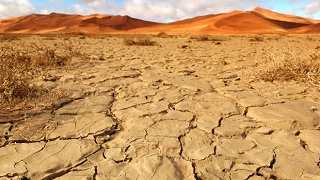Africa's bright future drying up?
 More than half of the world’s 30 fastest growing economies are in Africa. Much of the growth in these “frontier markets” is a product of low baseline GDP figures. In many of these countries there’s nowhere to go but up.
More than half of the world’s 30 fastest growing economies are in Africa. Much of the growth in these “frontier markets” is a product of low baseline GDP figures. In many of these countries there’s nowhere to go but up.Ernst & Young echoed many other observers when it said, “There is a new story emerging out of Africa: a story of growth, progress, potential and profitability.”
Despite the rosy projections of double-digit growth, many of these economies are dependent on small farmers often living hand-to-mouth on nutrient-poor land. The hope in many African capitals is to use growth to pull subsistence farmers out of poverty and modernize the sector across the region.
But some agricultural minsters and industry experts fear that global warming could derail the continent’s promising future, turning farms into wastelands in only a few decades.
Estimates by the UN Food and Agricultural Organization say that by 2030, two-thirds of the continent’s arable land will be lost to ever-encroaching deserts.
This loss of land would be devastating anywhere. But in a place where 75 percent of the population farms and agriculture makes up a third of all exports, a change like this could be dire for the future of the continent, impeding growth just as many African nations are emerging from decades of strife.
By World Bank estimates (pdf) The Democratic Republic of the Congo, Ghana, Ethiopia, Mozambique, Niger, Rwanda, Tanzania and Uganda will all see more than 13% growth in their economies in the next three years. These African nations are also all heavily dependent on agriculture for this growth.
In Niger, a poor, landlocked country straddling the Sahara, 40 percent of GDP comes from subsistence agriculture. Small farmers are at the mercy of weather patterns that are out of their control, living on the margins next to one of the world’s largest deserts. Adam Nossiter reports in The New York Times:
Niger is next to last on the United Nations’ Human Development Index, and is subject to droughts and near famines. In the last decade alone, there have been three serious food shortages related to low rainfall and insect attacks, and this year perhaps a third of the population is facing hunger.
Niger is one of a growing number of nations that have historically faced drought and staved off famine, now dealing with these pressures with increased frequency. It’s unclear whether this is largely because of climate change or a number of other factors. What is clear is that this is happening at a time when many of these countries seem like they are shedding their old images a basket-cases.
On the heels of a Rio+20 summit filled with handwringing and finger pointing between developed and developing nations, African delegates left with little more than a promise to fund the UN Environment Program. There were no specifics on how that would be done, or who foot the bill.
Many African delegates are looking to the UNEP to help fund a transition into greener economies, ones that allow small farmers to use their land more efficiently, lessen the threat of desertification and fight the effects of climate change.
Adam Mohammed Nour of Sudan’s Ministry of Environment, Forests and Physical Development told the UN’s African Renewal Magazine recently, “We are hoping that the green economy will bear fruit when it comes to combating desertification, poverty, and protecting the environment.”
You can return to the main Market News page, or press the Back button on your browser.

